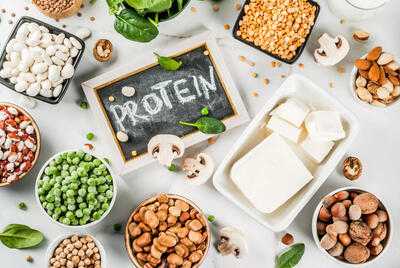From muscle growth and weight management to better bone health, protein has earned its place as a dietary star. Yet, in the era of fitness influencers and protein-packed everything, a pressing question remains: how much is actually enough? And can you go overboard?
Recent insights from USA Today and the Mayo Clinic reveal that while protein is essential for everything from building muscle to repairing tissue, the right amount depends on your weight, lifestyle, and age — and more protein is not always better.
Why Protein Matters Beyond Muscle
According to the U.S. Department of Agriculture, protein serves as the foundation for bones, muscles, blood, cartilage, hormones, and skin. It also boosts satiety, keeping you fuller for longer compared to carbs or fats.
That makes it particularly valuable for those managing their weight. Registered dietitian Jamie Nadeau told USA Today that aiming for at least 20 grams of protein per meal can help with satiety, though she stresses individual needs vary.
How Much Protein Do You Really Need?
The current recommended dietary allowance (RDA) is 0.8 grams per kilogram of body weight for sedentary adults. That’s about 54 grams a day for someone weighing 150 pounds.
But many experts now recommend higher targets, especially for active individuals or those over 40. Nadeau notes that muscle-building benefits often start at 1.2 to 1.4 grams per kilogram, which for that same 150-pound person translates to around 82 to 95 grams daily.
For regular exercisers, the Mayo Clinic advises between 1.1 and 1.7 grams per kilogram, depending on training intensity. However, exceeding 2 grams per kilogram daily could lead to kidney strain, higher cholesterol, or fat gain.
Why More Isn’t Always Better
The body cannot store excess protein. Once needs are met, surplus protein is either used for energy or stored as fat. The Mayo Clinic warns that high-protein diets heavy in red meat and saturated fats can raise heart disease risk, and that portion control is just as important as hitting daily targets.
Muscle growth also requires strength training — protein alone won’t do the trick. A bigger steak without exercise does not equal bigger muscles.
Spreading Intake Through the Day
Instead of loading all your protein at dinner, research suggests spreading 15–30 grams per meal could help with appetite control and muscle preservation. Breakfast, often the meal with the least protein, is a good place to start — think Greek yogurt with fruit, eggs with whole grain toast, or a smoothie with peanut butter and milk.
Nadeau also recommends including a high-protein snack (5–10 grams) daily to keep hunger in check.

Best Sources for a Balanced Plate
You don’t need to rely on protein powders or oversized meat portions to meet your needs. According to USDA data, top protein sources include:
Recent insights from USA Today and the Mayo Clinic reveal that while protein is essential for everything from building muscle to repairing tissue, the right amount depends on your weight, lifestyle, and age — and more protein is not always better.
Why Protein Matters Beyond Muscle
According to the U.S. Department of Agriculture, protein serves as the foundation for bones, muscles, blood, cartilage, hormones, and skin. It also boosts satiety, keeping you fuller for longer compared to carbs or fats.
That makes it particularly valuable for those managing their weight. Registered dietitian Jamie Nadeau told USA Today that aiming for at least 20 grams of protein per meal can help with satiety, though she stresses individual needs vary.
How Much Protein Do You Really Need?
The current recommended dietary allowance (RDA) is 0.8 grams per kilogram of body weight for sedentary adults. That’s about 54 grams a day for someone weighing 150 pounds.
But many experts now recommend higher targets, especially for active individuals or those over 40. Nadeau notes that muscle-building benefits often start at 1.2 to 1.4 grams per kilogram, which for that same 150-pound person translates to around 82 to 95 grams daily.
For regular exercisers, the Mayo Clinic advises between 1.1 and 1.7 grams per kilogram, depending on training intensity. However, exceeding 2 grams per kilogram daily could lead to kidney strain, higher cholesterol, or fat gain.
Why More Isn’t Always Better
The body cannot store excess protein. Once needs are met, surplus protein is either used for energy or stored as fat. The Mayo Clinic warns that high-protein diets heavy in red meat and saturated fats can raise heart disease risk, and that portion control is just as important as hitting daily targets.
Muscle growth also requires strength training — protein alone won’t do the trick. A bigger steak without exercise does not equal bigger muscles.
Spreading Intake Through the Day
Instead of loading all your protein at dinner, research suggests spreading 15–30 grams per meal could help with appetite control and muscle preservation. Breakfast, often the meal with the least protein, is a good place to start — think Greek yogurt with fruit, eggs with whole grain toast, or a smoothie with peanut butter and milk.
Nadeau also recommends including a high-protein snack (5–10 grams) daily to keep hunger in check.
Best Sources for a Balanced Plate
You don’t need to rely on protein powders or oversized meat portions to meet your needs. According to USDA data, top protein sources include:
- Lentils: 23.6 g per ½ cup dry
- Chicken breast: 22.5 g per 3.5 oz
- Salmon: 20.3 g per 3.5 oz
- Greek yogurt: 16.1 g per container
- Black beans: 9.9 g per ½ cup
- Peanut butter: 7 g per 2 tbsp
You may also like

Wrexham's record-breaking £10m transfer deal sparks Ryan Reynolds debate among fans

India well on way to become developed economy by 2047: President Murmu

After biker dies in tree collapse in Kalkaji, CM Gupta orders citywide pruning drive

Twitter down LIVE: Thousands of users unable to access X

India awards senior military officers who planned, executed Op Sindoor







